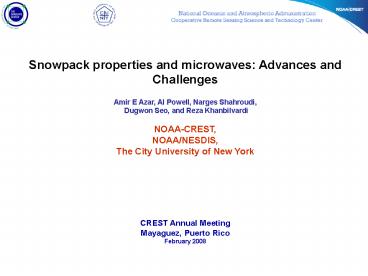Snowpack properties and microwaves: Advances and Challenges - PowerPoint PPT Presentation
1 / 17
Title:
Snowpack properties and microwaves: Advances and Challenges
Description:
Dense coniferous forest interspersed with open meadows; low rolling topography ... Moderately high-density coniferous forest, on wet north-facing slope. Alpine ... – PowerPoint PPT presentation
Number of Views:40
Avg rating:3.0/5.0
Title: Snowpack properties and microwaves: Advances and Challenges
1
Snowpack properties and microwaves Advances and
Challenges Amir E Azar, Al Powell, Narges
Shahroudi, Dugwon Seo, and Reza
Khanbilvardi NOAA-CREST, NOAA/NESDIS, The City
University of New York CREST Annual
Meeting Mayaguez, Puerto Rico February 2008
2
- Snow Water Equivalent (SWE)
- Algorithm development and improvement of SWE
estimated by satellite microwave data using
winter NDVI data in Great Lakes area - Snow Grain Size and Microwaves
- Analysis of snowpack behavior changes and their
effect on microwave emissions using - Satellite Brightness Temperature (Tb)
- Emissivity Data
- Analysis of snow pack profile and changes of its
properties with respect to each other - Development of a linear model to estimate snow
grain size profile based on temperature
3
Improvement of Microwave-based SWE Estimating
Algorithm over Great Lakes Area Using NDVI Data
SWE (A NDVI B)GTV SWECSSID GTV
(19v-37v), SSI (22v-85v) NDVI Winter time,
obtained from a 10-day composite image for
January 1994, A, B, C, and D entering the above
formula were found equal to 35, 2, 0.9, and -3
respectively.
4
The Microwave data are underestimating over the
forested area (surrounding the lake) by combining
the microwave with NDVI
SSM/I Data, DMSP
NDVI derived from AVHRR
5
Using snow emission model from Helsinki
University of Technology (HUT) the effect of snow
grain size on microwaves is quantified
Prigent, C. et al, 2006
6
- Comparison and Evaluation of snowpack properties
derived from SSM/I brightness temperature with
NASA-GISS Emisivities using snow emission model
(HUT) - The results indicate a better performance of
emissivity data in estimation of snow pack
properties
7
- Collected Data
- Snow Depth
- Snow Density
- Snow Temperature
- Snow Grain Size
Measurements in snow pits, (NSIDC) ,
www.nohrsc.nws.gov
8
Meso-cell (MSA) ,Intensive Study Area (ISA),
and Snow pits
- Meso-cell Study Area
- (25 x 25 km), from NSIDC
Depth
Intensive Study Area (ISA,1km x 1km), from NSIDC
Temperature
Grain Size
Density
9
Average of snow parameters (IOP 1 IOP2)
D2Depth in Feb. D3Depth in Mar. T2Snow
temperature in Feb. T3Snow temperature in
Mar. G2Grain size in Feb. G3Grain size in Mar.
10
- Variation of snow
- Temperature,
- Grain size, and
- Density
- in the snow profile
- Fraser Alpine (pits 6 and 12)
- Snow grain size and snow temperature, and snow
density are highly correlated within the profile
of snow
11
- Comparison of the correlation coefficients
- Grain size and Density
- Grain size and Temperature
- Snow grain size and snow temperature have high
and positive correlations - The correlation between snow density and snow
grain size is not consistent
12
Derivation of the Average Regression line
between snow grain size and snow temperature
The regression line slope and intercept changes
over various ISAs and MSAs
13
Derived equations for estimating snow grain size
using snow temperature profile and their
performance
14
- Error Increase over certain ISAs due to lack of
grain size measurements
- Snow pit 08 in ISA, Walton Creek has only 1
measurement for grain size below 80 cm depth
15
(A) estimated grain size using measured
temperature
(B) estimated grain size using estimated
temperature
IOP1 (Feb 2002)
IOP3 (Feb 2003)
16
- Winter NDVI data could successfully applied to
improve the estimated SWE by microwave data - Snow grain size has significant effects on
microwave emissions and it is a challenge to
account for those effects directly - Snow emission models such as HUT can be used to
evaluate the performance of Tb data vs.
emissivity data in estimating snow pack
properties - The correlation between snow grain size and snow
temperature is higher and more consistent as
compared with snow grain size and temperature - A regression line was derived based on the
correlations between snow temperature and snow
grain size - The snow grain size profile was estimated using
the temperature data
17
- Future Works
- Setting up a station to measure
- Microwaves (ground-based) in 37 GHz and 19GHz in
vertical and Horizontal polarizations - Snowpack properties (depth, SWE, and grain size)
- Temperatures (air, and snow)
- Validation of different radiative transfer models
including CRTM and MELMS using the obtained data - Application of the results to improve existing
satellite snow retrieval algorithms
PAMIR microwave radiometer































